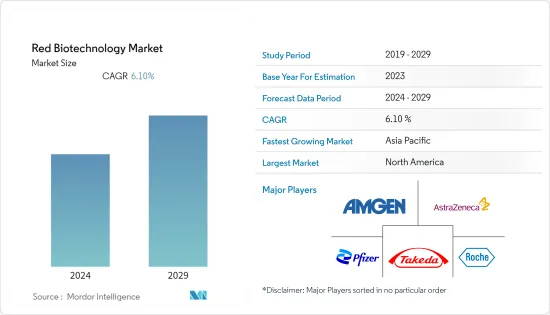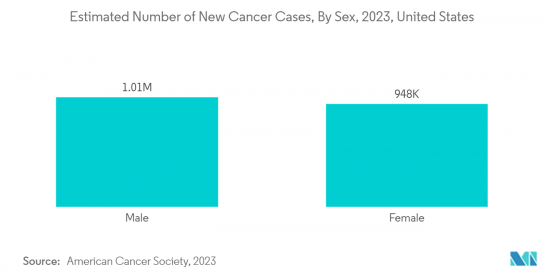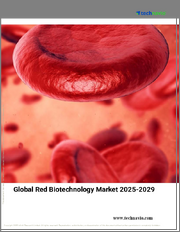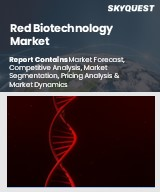
|
시장보고서
상품코드
1405680
레드 바이오 테크놀러지 : 시장 점유율 분석, 산업 동향 및 통계, 성장 예측(2024-2029년)Red Biotechnology - Market Share Analysis, Industry Trends & Statistics, Growth Forecasts 2024 - 2029 |
||||||
레드 바이오 테크놀러지 시장은 예측 기간 동안 연평균 복합 성장률(CAGR) 6.1%를 나타낼 것으로 예상됩니다.
COVID-19 팬데믹은 세계의 레드 바이오 테크놀러지 분야에 큰 영향을 미쳤습니다. 레드 바이오 테크놀러지는 진단, 유전자 치료, 임상 연구 및 임상시험 분야에서 중요한 역할을 담당합니다. 백신, 의약품, 진단 시약, 세포주, 유전자 치료 제품 등의 제조에 사용됩니다. 바이오 테크놀러지가 백신 제조에 제공하는 것은 많았고, 팬데믹은 백신의 발견과 승인에 큰 수요가 있었기 때문에 레드 바이오 테크놀러지 시장에 큰 영향을 주었습니다. 예를 들어, 2022년 3월에 NCBI가 발표한 논문에 따르면, COVID-19 바이러스의 대유행 이후, 몇몇 신흥 생명공학과 그 학제간 접근법은 분자의 상세한 이해와 광범위한 진단법 및 잠재적인 백신 후보의 개발을 가속화했습니다. 따라서 COVID-19는 처음에는 조사 대상 시장에 긍정적인 영향을 미쳤습니다. 그러나 팬데믹이 침전됨에 따라 레드 바이오 테크놀러지 시장은 본 연구의 예측 기간 동안 양호하고 안정적인 성장이 예상됩니다.

시장 성장을 가속하는 요인으로는 만성 질환이나 희귀질환의 이환율이나 유병률의 상승, 헬스케어 산업에 있어서의 자금 조달 증가 등을 들 수 있습니다. 예를 들어, 미국 암협회(ACS)가 2023년 1월에 발표한 데이터에 따르면, 미국에서는 2023년 말까지 약 195만8310명의 신규암 환자가 발생할 것으로 예측하였습니다. 이 자료에 따르면 2023년에는 미국에서 새로 약 30만 590명의 유방암 환자가 발생할 것으로 예측하였습니다. ACS는 또한 2022년에는 1,800만 명 이상의 미국인이 암의 기왕력이 있다고 보고되었다고 말했습니다. 또한 호주를 포함한 다양한 국가에서 신규 암 증례 증가도 예측 기간 중 시장 성장에 박차를 가할 것으로 예측되었습니다. 예를 들어, Australian Institute of Health and Welfare가 발표한 데이터에 따르면, 2022년 12월, 호주에서는 약 62,000명의 신규 암 증례가 진단되었습니다. 이 출처에 따르면, 호주에서 남성에게 가장 많이 진단된 암은 전립선암으로 24,217례, 흑색종으로 10,374례, 대장암으로 8,300례, 폐암으로 7,707례였습니다. 따라서 세계 암의 유병률 상승은 암 감별 진단 및 조기 진단, 종양 진행 억제, 적절한 암 치료를 뒷받침하는 레드 바이오 테크놀러지에 대한 수요를 촉진할 것으로 예측됩니다.
게다가 정부와 바이오 테크놀러지 분야의 유명 기업들이 자금을 늘려 시장 성장을 가속하고 있습니다. 예를 들어, 2022년 1월, 엘리 릴리 앤 컴퍼니는 엔토스 퍼머슈티칼스와 엔토스의 Fusogenix 핵산 전달 기술과 릴리 치료용 카고를 사용하여 여러 신경학적 적응증의 혁신적인 치료법 개발을 위한 연구개발 계약을 체결했습니다. 이 계약에 따라 엘리 릴리 앤 컴퍼니는 핵산 기반 치료제의 개발과 상업화를 위해 4억 달러를 투자합니다. 이러한 투자와 계약은 레드 바이오 테크놀러지의 연구개발을 진행시켜 예측기간 동안 시장 성장을 가속하게 됩니다.
따라서 암 유병률 증가와 유명한 기업들의 자금 제공 증가는 분석 기간 동안 레드 바이오 테크놀러지 시장의 성장을 뒷받침할 것으로 보입니다. 그러나 비싼 치료 기술 및 기계로 시장 성장이 억제될 전망입니다.
레드 바이오 테크놀러지 시장 동향
바이오 의약품 기업이 예측 기간 동안 큰 시장 점유율을 차지할 전망
바이오 의약품은 치료 및 진단 목적으로 사용되는 단백질, 항체, DNA, RNA, 안티센스 올리고 뉴클레오타이드이며, 이러한 제품은 원래의(비수술적인) 생물학적 소스에서 직접 추출 이외의 방법으로 제조됩니다. 바이오 제약기업은 바이오 의약품 및 약제에 대한 연구개발 활동 증가로 예측기간 동안 현저한 성장이 예상되고 있습니다.
유전자 기반 치료법의 개발과 같은 의료 생명공학 분야에서 현저한 발전이 나타납니다. 예를 들어, 2022년 5월, 노발티스는 CAR-T 세포 치료제 Kymriah(tisagenlecleucel)에 대해 2라인 이상의 전신 요법 후 재발 또는 난치성(r/r)의 여포성 림프종(FL)의 성인 환자를 치료 하기 위해 미국 식품 의약국의 승인을 받았습니다. 또한 2021년 3월 미국 식품의약국은 면역조절제, 프로테아좀 억제제, 항CD38 단클론항체를 포함한 4종 이상의 전치료력이 있는 재발 또는 난치성 다발성 골수종 성인 환자에 대한 치료제 이데카부타젠비크루셀(아베쿠마사 제품, 브리스톨 마이어스 스퀴브사)를 승인했습니다. 이 약은 식품의약국(FDA)이 승인한 최초의 다발성 골수종에 대한 세포 기반 유전자 치료제입니다.
클리블랜드 클리닉 보고서 2021에 따르면 유전자 질환도 희귀질환의 원인이 될 수 있습니다. 이 질병군은 미국에서 약 20만명이 걸립니다. 전문가에 따르면, 이러한 질병은 7,000에 이를 수 있습니다. 만성 질환 및 희귀질환의 이환율과 유병률 증가, 바이오 의약품 산업의 급속한 확대가 바이오 의약품 기업 부문의 성장의 주요 촉진요인이 되고 있습니다.
그러므로 유전질환 증가 및 유력기업에 의한 제품 출시의 급증으로 바이오 의약품기업 부문은 예측기간 중에 큰 성장을 이룰 것으로 예상됩니다.

북미가 시장에서 큰 점유율을 차지할 것으로 예상되며 예측기간 동안도 마찬가지로 예상됨
레드 바이오 테크놀러지 시장의 지역별 분석에 따르면 북미는 세계 시장에서 큰 점유율을 차지하고 있습니다. 이는 이 지역의 만성 질환 및 희귀질환의 유병률 상승, 연구개발 활동의 활성화, 높은 기술 진보에 의한 것입니다.
예를 들어 American Cancer Society update 2023에 따르면 2023년에는 미국에서 새롭게 190만명 이상의 암 환자가 진단될 전망이었습니다. 미국에서 암으로 진단받는 사람의 88%는 50세 이상, 57%는 65세 이상입니다. 이와 같이 암 환자 증가와 노인 인구 증가가 함께, 이 나라 시장 성장을 견인할 것으로 예상됩니다. 게다가 정부와 시장 관계자가 유전성 질환에 관한 연구를 촉진하기 위해 지출을 늘리고 있는 것도 시장 성장을 크게 뒷받침하고 있습니다. 예를 들어, 2023년 3월에 업데이트된 국립위생연구소 기사에 따르면 유전자 치료를 위한 지출은 2021년 4억 8,600만 달러, 2022년 5억 6,000만 달러였습니다. 또한 같은 출처에 따르면 유전자 연구에 대한 지출은 전년도 110억 1,000만 달러, 올해 116억 1,500만 달러였습니다. 마찬가지로 미국 보건통계센터(NCHS)가 2023년 3월 발표한 데이터에 따르면 미국에서는 향후 수년간 핵산을 이용한 연구에 대한 투자가 증가할 전망입니다. 이 출처에 따르면 유전학 연구비는 내년까지 16억 1,500만 달러에서 124억 4,500만 달러로 증가합니다. 같은 정보 근육은 유전자 검사에 대한 연구 투자가 올해 2억 1,400만 달러에서 내년에는 2억 3,700만 달러로 증가할 것으로 예측했습니다. 게다가 유전자 치료 조사금은 올해 5억 1,600만 달러에서 내년에는 5억 4,000만 달러로 증가합니다.
이와 같이 암 유병률의 상승과 유전학과 유전자 치료의 연구개발에 대한 높은 지출은 예측기간 동안 지역의 레드 바이오 테크놀러지 시장의 성장을 가속시킬 것으로 예측되고 있습니다.
레드 바이오 테크놀러지 산업 개요
레드 바이오 테크놀러지 시장은 경쟁이 심하고 소수의 선도 기업으로 구성되어 있습니다. 현재 여러 회사의 대기업이 시장 점유율로 시장을 독점하고 있습니다. 일부 유력 기업들은 세계 시장 포지션을 강화하기 위해 M&A에 많은 투자를 하고 있습니다. 현재 시장을 독점하고 있는 기업으로는 화이자, 아스트라제네카, F. 호프만 라 로슈, 다케다 약품산업, 암젠 등이 있습니다.
기타 혜택 :
- 엑셀 형식 시장 예측(ME) 시트
- 3개월간의 애널리스트 서포트
목차
제1장 서론
- 조사의 전제조건 및 시장 정의
- 조사 범위
제2장 조사 방법
제3장 주요 요약
제4장 시장 역학
- 시장 개요
- 시장 성장 촉진요인
- 만성 질환 및 희귀질환의 발생률 및 유병률의 상승
- 헬스케어 산업에 있어서의 자금 조달 증가
- 시장 성장 억제요인
- 고가의 치료 기술 및 기계
- Porter's Five Forces 분석
- 공급기업의 협상력
- 구매자 및 소비자의 협상력
- 신규 참가업체의 위협
- 대체품의 위협
- 경쟁 기업간 경쟁 관계의 강도
제5장 시장 세분화(시장 규모)
- 제품별
- 백신
- 의약품
- 기타
- 최종 사용자별
- 바이오 제약 회사
- CMO 및 CRO
- 기타
- 지역별
- 북미
- 미국
- 캐나다
- 멕시코
- 유럽
- 독일
- 영국
- 프랑스
- 이탈리아
- 스페인
- 기타 유럽
- 아시아태평양
- 중국
- 일본
- 인도
- 호주
- 한국
- 기타 아시아태평양
- 중동 및 아프리카
- GCC
- 남아프리카
- 기타 중동 및 아프리카
- 남미
- 브라질
- 아르헨티나
- 기타 남미
- 북미
제6장 경쟁 구도
- 기업 프로파일
- Pfizer Inc.
- AstraZeneca PLC
- F. Hoffmann-La Roche Ltd
- Bristol Myers Squibb(Celgene Corporation)
- Takeda Pharmaceutical Company Limited
- Biogen Inc.
- Amgen Inc.
- Gilead Sciences Inc.
- Merck & Co. Inc.
- CSL Limited
제7장 시장 기회 및 앞으로의 동향
AJY 24.01.22
The red biotechnology market is expected to register a CAGR of 6.1% over the forecast period.
The COVID-19 pandemic had a significant impact on the red biotechnology sector globally. Red biotechnology is an important part of the fields of diagnostics, gene therapy, and clinical research and trials. It is used to manufacture vaccines, drugs, diagnostic reagents, cell lines, gene therapy products, and so on. Since biotechnology had a lot to provide for vaccine production, the pandemic significantly influenced the red biotechnology market since vaccine discovery and approvals were in high demand. For instance, according to the article published by the NCBI in March 2022, since the COVID-19 virus outbreak, several emerging biotechnologies and their multidisciplinary approaches accelerated the understanding of molecular details and the development of a wide range of diagnostics and potential vaccine candidates. Hence, COVID-19 had a positive impact on the studied market initially; however, as the pandemic has subsided, the red biotechnology market is expected to have favourable and stable growth during the forecast period of the study.
The factors driving the market growth include the rising incidence and prevalence of chronic and rare diseases and increased funding in the healthcare industry. For instance, according to the data released by the American Cancer Society (ACS) in January 2023, approximately 1,958,310 new cancer cases are projected to occur in the United States by the end of 2023. As per the same source, around 300,590 new breast cancer cases are predicted to happen in the United States in 2023. ACS also stated that over 18 million Americans were reported to have a history of cancer in the year 2022. In addition, the rising number of new cancer cases in various countries, including Australia, is also projected to burgeon market growth during the forecast period. For instance, according to the data released by the Australian Institute of Health and Welfare, in December 2022, approximately 62,000 new cancer cases were diagnosed in Australia in 2022. As per the same source, the most diagnosed cancers in males in the country were prostate cancer with 24,217 cases, melanoma with 10,374 cases, colorectal cancer with 8,300 cases and lung cancer with 7,707 cases. Therefore, the rising prevalence of cancer worldwide is projected to drive the demand for red biotechnology to boost the differential and early diagnosis of cancer, tumour progression control, and proper cancer treatment.
Moreover, increased funding by the government and prominent players in the biotechnology field has been driving market growth. For instance, in January 2022, Eli Lilly and Company signed a research and collaboration agreement with Entos Pharmaceuticals to develop innovative therapies in multiple neurologic indications, using Entos' Fusogenix nucleic acid delivery technology and Lilly's therapeutic cargo. Under the agreement, Eli Lilly and Company will fund USD 400 million for the developmental and commercialization of the nucleic acid-based therapeutic. Thus, with such investments and agreements, the R&D of red biotechnology will advance, which is set to drive market growth during the forecast period.
Thus, the rising prevalence of cancer and increasing funding by prominent players are likely to boost the growth of the red biotechnology market over the analysis period. However, the market's growth is set to be restrained by costly therapeutic technology and machinery.
Red Biotechnology Market Trends
The Biopharmaceutical Companies Segment is Expected to Hold a Significant Market Share Over the Forecast Period
Biopharmaceuticals are proteins, antibodies, DNA, RNA, or antisense oligonucleotides used for therapeutic or diagnostic purposes, and these products are produced by means other than direct extraction from a native (non-engineered) biological source. The biopharmaceutical companies segment is expected to witness tremendous growth during the forecast period owing to the increasing R&D activities related to biopharmaceutical drugs and medications.
There has been significant development in the field of medical biotechnology, including the development of gene-based therapies. For example, in May 2022, Novartis received the United States Food and Drug Administration approval for CAR-T cell therapy Kymriah (tisagenlecleucel) to treat adults with relapsed or refractory (r/r) follicular lymphoma (FL) following two or more lines of systemic therapy. Moreover, in March 2021, the United States Food and Drug Administration approved idecabtagene vicleucel (Product from Abecma, Bristol Myers Squibb) for the treatment of adult patients with relapsed or refractory multiple myeloma after four or more prior lines of therapy, including an immunomodulatory agent, a proteasome inhibitor, and an anti-CD38 monoclonal antibody. This is the first Food and Drug Administration-approved cell-based gene therapy for multiple myeloma.
According to the Cleveland Clinic Report 2021, genetic disorders may also cause rare diseases. This group of conditions affects around 200,000 people in the United States. Experts say there may be as many as 7,000 of these diseases. The increasing incidence and prevalence of chronic and rare diseases and the rapid expansion of the biopharmaceutical industry are the key driving factors for the growth of the biopharmaceutical companies segment.
Therefore, the biopharmaceutical companies segment is expected to witness significant growth over the forecast period due to the increasing number of genetic disorders and surging number of product launches by prominent players.

North America is Expected to Hold a Significant Share in the Market and it is Expected to do the Same in the Forecast Period
The geographical analysis of the Red Biotechnology market shows that North America holds a significant market share in the global market. This is due to the rising prevalence of chronic and rare diseases, growing R&D activities, and high technological advancements in this region.
For instance, according to the American Cancer Society update 2023, over 1.9 million new cancer cases are expected to be diagnosed in the United States in 2023. 88% of people diagnosed with cancer in the United States are 50 or older, and 57% are 65 or older. Thus, an increase in cancer cases coupled with an increase in the geriatric population is expected to drive market growth in the country. In addition, the growing spending by the government and market players for boosting research on genetic diseases significantly boosts market growth. For instance, according to the National Institute of Health's article updated in March 2023, the spending for gene therapy was USD 486 million in 2021 and USD 560 million in 2022. Also, as per the same source, the spending on genetics research was USD 11,010 million the previous year and USD 11,615 million in the current year. Similarly, as per the data published by the National Center for Health Statistics (NCHS) in March 2023, research investments in nucleic acid-based research are expected to increase in the coming years in the United States. The source stated that the research funding in Genetics would likely elevate from USD 1,615 million to USD 12,445 million by next year. The same source noted that the research investments in Genetic Testing are anticipated to increase from USD 214 million in the current year to USD 237 million by next year. Also, the research funding in gene therapy will rise from USD 516 million in the current year to USD 540 million by next year.
Thus, the rising prevalence of cancer and high spending on research and development in genetics and gene therapy is projected to accelerate the regional red biotechnology market growth during the forecast period.
Red Biotechnology Industry Overview
The red biotechnology market is competitive and consists of a few significant players. A few of the major players are currently dominating the market in terms of market share. Some prominent players invest heavily in mergers and acquisitions to consolidate their market positions worldwide. Some companies currently dominating the market are Pfizer Inc., AstraZeneca PLC, F. Hoffmann-La Roche Ltd., Takeda Pharmaceutical Company Limited, and Amgen Inc., among others.
Additional Benefits:
- The market estimate (ME) sheet in Excel format
- 3 months of analyst support
TABLE OF CONTENTS
1 INTRODUCTION
- 1.1 Study Assumptions and Market Definition
- 1.2 Scope of the Study
2 RESEARCH METHODOLOGY
3 EXECUTIVE SUMMARY
4 MARKET DYNAMICS
- 4.1 Market Overview
- 4.2 Market Drivers
- 4.2.1 Rising Incidence and Prevalence of Chronic and Rare Diseases
- 4.2.2 Increased Funding in the Healthcare Industry
- 4.3 Market Restraints
- 4.3.1 Costly Therapeutic Technology and Machinery
- 4.4 Porter's Five Forces Analysis
- 4.4.1 Bargaining Power of Suppliers
- 4.4.2 Bargaining Power of Buyers/Consumers
- 4.4.3 Threat of New Entrants
- 4.4.4 Threat of Substitute Products
- 4.4.5 Intensity of Competitive Rivalry
5 MARKET SEGMENTATION (Market Size by Value - USD)
- 5.1 By Product
- 5.1.1 Vaccines
- 5.1.2 Drugs
- 5.1.3 Others
- 5.2 By End User
- 5.2.1 Biopharmaceutical Companies
- 5.2.2 CMOs and CROs
- 5.2.3 Others
- 5.3 Geography
- 5.3.1 North America
- 5.3.1.1 United States
- 5.3.1.2 Canada
- 5.3.1.3 Mexico
- 5.3.2 Europe
- 5.3.2.1 Germany
- 5.3.2.2 United Kingdom
- 5.3.2.3 France
- 5.3.2.4 Italy
- 5.3.2.5 Spain
- 5.3.2.6 Rest of Europe
- 5.3.3 Asia-Pacific
- 5.3.3.1 China
- 5.3.3.2 Japan
- 5.3.3.3 India
- 5.3.3.4 Australia
- 5.3.3.5 South Korea
- 5.3.3.6 Rest of Asia-Pacific
- 5.3.4 Middle East and Africa
- 5.3.4.1 GCC
- 5.3.4.2 South Africa
- 5.3.4.3 Rest of Middle East and Africa
- 5.3.5 South America
- 5.3.5.1 Brazil
- 5.3.5.2 Argentina
- 5.3.5.3 Rest of South America
- 5.3.1 North America
6 COMPETITIVE LANDSCAPE
- 6.1 Company Profiles
- 6.1.1 Pfizer Inc.
- 6.1.2 AstraZeneca PLC
- 6.1.3 F. Hoffmann-La Roche Ltd
- 6.1.4 Bristol Myers Squibb (Celgene Corporation)
- 6.1.5 Takeda Pharmaceutical Company Limited
- 6.1.6 Biogen Inc.
- 6.1.7 Amgen Inc.
- 6.1.8 Gilead Sciences Inc.
- 6.1.9 Merck & Co. Inc.
- 6.1.10 CSL Limited

















